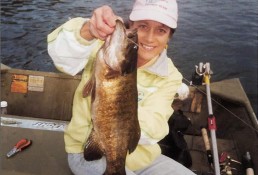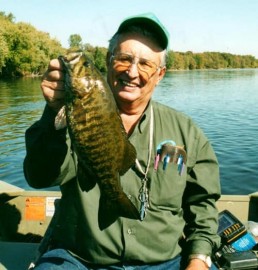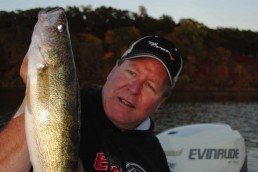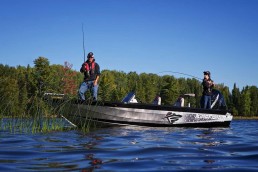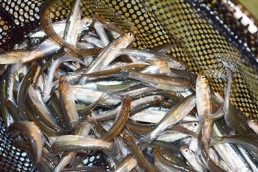My Favorite Fall River Structure: Lifts!
SHARE THIS POST
Autumn is the time to talk about River Lifts, structures that attract a great many trophy bass and walleyes at this time of year.
I’ve really liked fishing these the past 26 years with my Hall of Fame partner, Dan Gapen, Sr. You might not know it, but Dan belongs to no fewer than three fishing halls of fame, beginning with the International organization. With such credentials, the knowledge he’s bestowed on me is massive and extremely important.
River lifts
Over the years, the Ol’ River Rat has heaped a lot of fishing knowledge on me, and one of our September-October traditions is to “hit the Lifts” on rivers across the Midwest.
So what the heck is a Lift?
It’s hardpan structure that causes current flow to rise upward. You’ll find Lifts directly upstream from shallow, rocky rapids. As mentioned, we hit Lifts hard in the fall, but they hold fish all summer, too.
Look at Dan’s drawings, diagrams 1 and 2. These show a typical Lift.
Spot A is along a regular river bottom, composed typically of sand, gravel, or mud. It’s here where the Lift structure begins, and you’ll likely find rough fish like carp and suckers. These fish are attracted mainly by insect larvae.
As you move up to spot B, in 9 feet of water, you’ll generally find walleyes. Here, walleyes are able to take advantage of schools of baitfish that have held up their downstream progress in order to avoid entering the rougher water they’ll be subjected to further downstream. Here, the bottom has become a gravel and rock mixture, and many baitfish can find protection by holding tight to bottom in rocky crevices.
As we travel up the Lift structure, we find bass in about 6 feet at the spot marked C. Here, the bottom becomes rougher and rockier. Bass are able to engage baitfish, especially bigger ones that have managed to avoid the walleyes and saugers down deeper along the Lift.
At spot D, on “top of the Lift” in the fast, wavy water, you’ll find muskies and pike if these species are in the river system you fish. These should be worked first with a crankbait such as a shallow-running 6-inch Flub Dub or any large minnow bait you have along. If you work the big predators at spot D from a boat, don’t worry about disrupting the bass and walleyes. They can be distracted by running over them. They return to their feeding position moments after being disturbed and flushed.
River fish of all species, when disturbed by a boat passing overhead, will return almost immediately after the disturbance. In 99 percent of cases, this is true. These fish on a Lift are no different. By the time you anchor, they’ll be back in their “holding” positions.
Are you enjoying this post?
You can be among the first to get the latest info on where to go, what to use and how to use it!
How to fish a Lift
Upstream trolling over a Lift will work, but takes up a great deal of time. Anchoring as shown on diagram 2 will be the best method of fishing this structure. From this position, you can systematically work the structure, first taking the big walleyes at spot B, then the trophy bass at spot C.
Big baits on fall Lifts
Now we come to the most important reason we target Lifts in the fall: most of the fish will be big, even trophy size. This is the time of year to use large baits, both artificial and live. Use 6-inch-plus chubs, preferably redtail chubs if your bait dealer has them. If not, regular river chubs or horny-head chubs will do. The last resort in big live bait would be sucker minnows. We have found that sucker minnows catch half as many fish off fall Lifts as do chubs. Buy the 6- to 8-inch size.
As I’ve mentioned, chubs, especially redtails, are deadly on fall staging gamefish. Use a 2-ounce Bait Walker Sinker with a 24-inch drop-back line to the hook (a 3/0 short-shanked style hook will do). Hook the chub from under the lower jaw, then up and out through the upper jaw. Make sure the hook’s barb penetrates the front of the nose. This leaves your chub lively and able to swim freely.
Don’t worry about these fall fish not being a “hook up” on strike. You miss very few strikes this time of year. One example of this is two falls ago, when Dan and I caught and released 29 smallies, four walleyes and one muskie, all hooked this way, with very few misses. Fall staging bass and walleyes charge the bait, come up alongside it, then smash it on the head.
You’re rarely, if ever, left wondering whether you just had a bite, and you rarely have to set the hook. The hook setting, for the most part, is performed by the fish, helped by you tightening up the line and reeling.
If it’s artificial lures you prefer to use, select one at least 6 inches in length, with a shallow-diving lip if the water is no deeper than 6 to 8 feet. If the water is deeper than that, use a deeper-diving crankbait. Getting down to the bass at C is necessary, thus the deep-lipped crank. Any style crankbait will do, but I’d pick a deep-lipped Flub Dub in Shad or Gold Roach color. The holograph spinner under the crankbait will act not only as an attractor but as snag-avoidance mechanism, as you work it over the Lift’s rocky bottom
This “big fish on the Lifts” pattern will last from mid September to late October in the northern states. In the South, it’s possible for it to produce from late November through December. Look for erratic water and boils on the rivers you fish. You can bet that upstream from these disturbances you’ll find a Lift. If you haven’t fished there, fall is the time to start.
More developments coming in 2017
We are having so much fun bringing you our latest discoveries here in MidWest Outdoors. In addition to river Lifts, we also went into detail on the new concept of Benthic Zones, first discussed in the January, February, and March, 2016 issues of MidWest Outdoors.
Awareness of Benthic Zones, which my underwater video filming documented, will change the way you approach fishing in rivers.
Our continuing work with underwater video is allowing us to discover and confirm things we had only guessed at in the past. It’s a really exciting time to be part of the Gapen team! Meanwhile, Dan, the Ol’ River Rat, will be back next month, while I’ll be on the water using my underwater video gear to capture proof of the surprise we have in store for you in the January, February and March, 2017 issues of MidWest Outdoors.
So get out there and fish some Lifts, then get ready to read, as you prepare for a great season in 2017.
MWO
SHARE THIS POST
Did you enjoy this post?
You can be among the first to get the latest info on where to go, what to use and how to use it!
'Bobber' Anne Orth
Known in the fishing world as ‘Bobber’ Anne, she has co-hosted countless TV fishing & hunting shows, throughout the Americas, since 1991. Her primary efforts include filming fish strikes on underwater video, giving family seminars, writing articles, and conducting sales for Gapen Tackle Company. In 2018, she was inducted into the National Fresh Water Fishing Hall of Fame.
